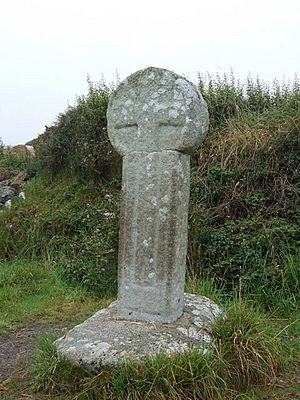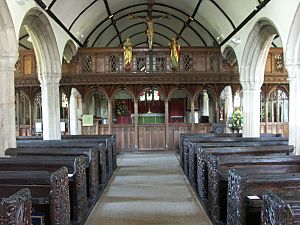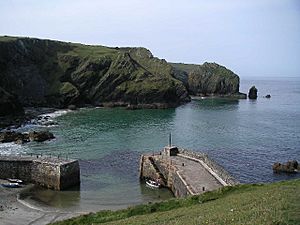Mullion, Cornwall facts for kids
Quick facts for kids Mullion
|
|
|---|---|
 The church of St Mellanus |
|
| Lua error in Module:Location_map at line 530: Unable to find the specified location map definition: "Module:Location map/data/Cornwall (mainland)" does not exist. | |
| Population | 2,114 (Civil parish, 2011) |
| OS grid reference | SW678192 |
| Civil parish |
|
| Unitary authority | |
| Ceremonial county | |
| Region | |
| Country | England |
| Sovereign state | United Kingdom |
| Post town | HELSTON |
| Postcode district | TR12 |
| Dialling code | 01326 |
| Police | Devon and Cornwall |
| Fire | Cornwall |
| Ambulance | South Western |
| EU Parliament | South West England |
| UK Parliament |
|
Mullion (called Eglosvelyan in Cornish) is a village and a local area (known as a civil parish) in south Cornwall, England. It's located on the beautiful Lizard Peninsula. The closest town is Helston, which is about 5 miles (8 km) north of Mullion.
Mullion civil parish includes the main village, which used to be called the "church town." It also has four smaller areas: Mullion Cove and Predannack to the southwest, and Trewoon and Meaver to the east. Mullion is surrounded by other parishes like Gunwalloe and Cury to the north. To the east is Grade-Ruan, and to the south is Landewednack. To the west, it meets Mount's Bay.
The parish also includes Mullion Island. This island is about half a mile (0.8 km) from Mullion Cove. No one lives on the island, but it's home to many seabirds. The National Trust owns this special island.
Contents
The Name of Mullion
The name of Mullion has changed a lot over time. Old records show names like St Mullyon, St Mullian, and Mullyan. In 1535, the village was called Melyan.
The parish gets its name from Melaine, a saint from Brittany. He was a bishop in France around the year 519. He was also known by his Latin name, Saint Melanius. Until the early 1900s, the local church was officially called St Melan's.
Mullion's History
Mullion has a long history. People lived here even in the Bronze Age. We know this from ancient burial mounds found in the area. There are also Celtic crosses and old chapel sites.
More recently, people mined for copper and china clay here. During World War II, there was an airfield at Predannack. Several burial mounds at Angrowse have shown prehistoric remains when dug up. A Cornish cross stands near the small village of Predannack. It has a Latin cross shape carved on both sides.
An old Celtic church likely existed here. Place names like Tremenehee ("sanctuary town") and Lanfrowder suggest this. In Norman times, the church of St Melanus was given to a priory. Later, it went to the Dean and Chapter of Exeter. The church you see today was mostly built in the 15th century. It has beautiful old wooden carvings, including the ends of the church benches.
Shipwrecks and Lifeboats
The coast near Mullion can be dangerous. In the six years leading up to 1873, nine ships were wrecked here. Sixty-nine lives were lost in these accidents. Because of this, the Royal National Lifeboat Institution started a lifeboat station at Mullion Cove in 1867. This station helped save lives until it closed in 1908. The old boathouse is gone, but its barometer (a weather tool) is still in the village.
Fishing and Mining in Mullion
Like many Cornish villages, Mullion had a busy pilchard fishery. This started in the 1700s from Mullion Cove. Fishermen used large seine nets to catch pilchards. The fish were then cured (preserved) in Newlyn. They were sent to countries around the Mediterranean Sea.
A "huer" (a lookout) would stand on Mullion Island. They would watch for dark patches in the water, which meant a large group of pilchards was nearby. Today, a few boats still operate here, catching shellfish.
Mullion also had some copper mines, but they didn't last long. They had different names like Wheal Unity and Wheal Fenwick. In 1847, a huge sheet of native copper was found at Wheal Unity. It was 9 meters (29.6 feet) long and weighed over 700 kg (1,500 pounds)! This amazing piece was shown at the Great Exhibition in London in 1851. Copper mining here stopped by the late 1800s.
Talc Quarrying
In the 1700s, people quarried talc at Soapy Cove. Talc is a soft mineral found in the local serpentine rock. The old quarries look like scars on the land near the shore. Talc from here was used to make early porcelain (a type of ceramic) by companies like Worcester Porcelain.
Marconi's Wireless Signal
Poldhu is a very important place in history. In 1901, Marconi sent the first ever wireless signal across the Atlantic Ocean from here. It reached St John's, Newfoundland. This was a huge step forward! It led to the invention of radio, television, satellites, and the internet. The Goonhilly Satellite Earth Station, a large satellite dish site, is a nearby example of this technology today.
Mullion's Geography and Nature
Mullion parish covers about 5,007 acres (20.26 km²) of land. It is part of the Lizard Peninsula, which is a Cornwall Area of Outstanding Natural Beauty (AONB). This means it's a specially protected area for its amazing scenery.
Mullion has three Sites of Special Scientific Interest (SSSIs). These are places protected for their special geology or wildlife. They include West Lizard SSSI, Baulk Head to Mullion SSSI, and Mullion Cliff to Predannack Cliff SSSI. This last SSSI also includes Mullion Island. These areas are known for their unique rocks and many rare plants. A large part of the Lizard National Nature Reserve (NNR) is also within Mullion. The South West Coast Path, a famous walking trail, runs along the cliffs here.
Mullion Village and Surroundings
The main village of Mullion is in the north of the parish. It sits about 65 meters (210 feet) above sea level. It's about 1 mile (1.6 km) inland from the coast. The village is at the end of two river valleys that lead down to the sea at Polurrian Cove and Mullion Cove. Another valley north of the village forms the border with Gunwalloe parish.
The land around the village is very fertile. Farmers grow crops and raise animals here. The small villages of Trewoon and Meaver are about half a mile east of Mullion. Today, Mullion is the biggest village on the Lizard Peninsula. It offers local services and is a popular spot for tourists. Mullion School is the local secondary school for older kids.
Predannack Downs and Coastline
South of Mullion village, the land rises to a flat area called Predannack Downs. This area is mostly natural heathland. This type of land is encouraged by the different rocks found here, which are mainly serpentinite. Predannack Downs is part of the Lizard National Nature Reserve.
In the middle of the downs is Predannack Airfield. This airfield was built during World War II. Today, it is used by RNAS Culdrose, a nearby naval air station.
The southern edge of the parish has a steep, narrow river valley. This valley meets the sea at Kynance Cove. The coastline along the downs has dramatic, high cliffs. One special spot is Gew-graze, also called Soapy Cove. This cove is named after soapstone, a type of talc-rich rock found there. As mentioned before, talc was quarried here in the 1700s.
Local Government
For local government, Mullion is a civil parish. Every four years, people in Mullion elect a parish council. This council has ten members who help manage local matters. The main local authority for the area is Cornwall Council. An electoral ward (a voting area) called Mullion covers the parish and the land down to Lizard Point. In 2011, about 4,364 people lived in this ward.
Sports in Mullion
Mullion has several sports clubs. Mullion AFC is a local football club. They play their home games at Clifton Parc. The main team plays in the Cornwall Combination League. There's also a reserve team and a women's team.
Mullion Cricket Club plays in the second division of the Cornwall Cricket League. Mullion Golf Club was started in 1895. It's the most southerly golf course in the UK. It is actually located in the nearby parish of Gunwalloe.
Cornish Wrestling
Cornish wrestling tournaments used to be held in Mullion. Wrestlers would compete for prizes.
Famous People from Mullion
- Svetlana Alliluyeva (1926–2011), also known as Lana Peters, was the daughter of Joseph Stalin. She lived in Mullion for some time.
- Stephen Halden Beattie VC (1908–1975) was a brave naval captain. He won the Victoria Cross for leading HMS Campbeltown to destroy dock gates in France during a raid.
- James Erisey (born around 1560) was a privateer (a legal pirate) who sailed with Sir Francis Drake. He was born near Mullion.
- Andrew Henry George (born 1958) is a British politician. He was a Member of Parliament (MP) for St Ives from 1997 to 2015.
- Ernest Herbert Pitcher, VC, (1888–1946) was a petty officer in the Royal Navy. He also won the Victoria Cross.
- Sheila Tracy (1934–2014) was a British broadcaster, writer, and musician. She started her career playing the trombone in all-female bands. She was born in Mullion.
- Squadron Leader Geoffrey Wellum DFC (1921–2018) was a British fighter pilot in the Battle of Britain. He was also an author and retired to Mullion in the 1980s.
See also
 In Spanish: Mullion para niños
In Spanish: Mullion para niños






